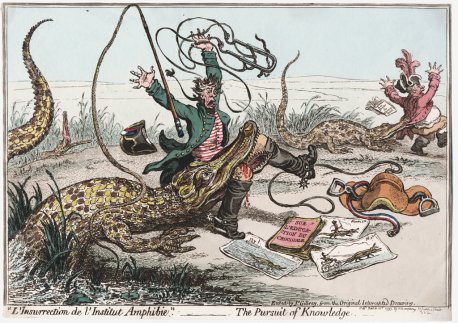L'Insurrection de L'Institut Amphibie
Overview
L'Insurrection de L'Institut Amphibie [ edit ]
On August 22, 1798, General Napoleon Bonaparte founded the “Institute of Egypt,” whose scientific members were charged with studying ancient and modern Egypt through different fields. Initial projects included the purification of Nile water, the explanation of desert mirages, and the study of ibis mummies (for examples see the Animal Mummies in Mummy-Mania). “L’Insurrection de l’Institute Amphibie” is a satire depicting two Frenchmen on the banks of the Nile, who have been unsuccessful in their attempts to domesticate the Egyptian crocodile. It is one of a series of “Egyptian Sketches” by graphic satirist James Gillray that articulates British disdain for the supposed purpose of the Institut d’Égypte, founded in Cairo on August 22, 1798. Under the pretext of acknowledging an ancient alliance between France and the Ottoman Empire, the French Directory decreed General Napoleon Bonaparte to invade Egypt and assist the Ottoman sultans with Mamluk misrule. In truth this conquest, launched on July 1, 1798, was a systematic attempt to sever communication between Britain and India, its most important colonial possession, while protecting French trade in the region. The invasion was further justified as an intellectual mission to seize the scientific and cultural histories of Egypt from the grasp of Mamluk barbarism and religious ferocity. Along with his military forces, General Bonaparte conveyed to Egypt savants—scholars, engineers, and scientists—and formed the Institut d’Égypte, an academy of arts and science established to discover the knowledge of Egypt and disseminate scholarship to the rest of Europe. This etching demonstrates the British belief that enthusiasm for the French expedition in Egypt was unmerited and also refers to Britain’s counter-propaganda. Gillray attributed the design of the print as being derived “from the Original intercepted drawing,” a fictitious portfolio of works by an “ingenious young Artist.” This is an allusion to a collection of letters, purportedly written by members of the French army and intercepted during various naval victories of Admiral Horatio Nelson’s fleet, which was published in an effort to reveal the true motivation for establishing the Institut—to conquer Europe’s intellectual elite. Gillray renames the organization the “L’Institut Amphibie,” suggesting the double and therefore dubious modes of existence, a circumstance he predicts will soon injure the French, symbolized by the plight of the central figure. Three plates, demonstrating the progression of the crocodile under French instruction from an animal that can be ridden, to one that can draw a phaeton and even pull a Nile barge, have fallen out of the book entitled SUR L’EDUCATION DU CROCODILE, while, in the distance, another Frenchman will suffer presently for his belief in the “Les Droits du Crocodile,” (The Rights of Crocodile), a parody of Anglo-American author Thomas Paine’s defense against the French Revolution, The Rights of Man (1791).
In the other satirical cartoon, the figures depicted are often identified as Admiral Horatio Nelson and his lover, the artist model and performer, Emma, Lady Hamilton, who attempt to conceal their passionate embrace within an Egyptian sarcophagus, the spoils of his victory of the Battle of the Nile. The hunched, elderly man in the background, shown peering through a quizzing glass at two Egyptian statues, is by extension thought to be Emma’s husband, the former ambassador of Naples and renowned antiquary, Sir William Hamilton. Several aspects of this print challenge this identification, not least of which is the portrayal of Lord Nelson in a regimental uniform (blue coloring notwithstanding) with his right arm intact. Lord Nelson emerged as a public hero in July of 1797 with actions in the Mediterranean against the Spanish navy and, shortly after stepping ashore on the Spanish island of Tenerife, suffered compound fractures when he was hit in the right arm by a musket ball; he was brought aboard the HMS Theseus where the arm was immediately amputated. James Gillray, Isaac Cruikshank, Charles Williams, as well as Thomas Rowlandson, featured the Admiral in satires without his right hand, a technique the subject anticipated, exemplified by a letter he wrote to Emma in 1801: “How I should laugh to see you . . . the beautiful Emma rowing a one-armed Admiral in a boat! it will certainly be caricatured!” Rather than being a comment on the Hamilton affair, published well after the death of both Sir William and Lord Nelson, it is more likely that Rowlandson merely alluded to the liaison in order to highlight the supposed nature of the antiquary, one so disconnected from the state of the living that even a passionate romp could not tempt him from his minute, even lascivious inspection of the products of antiquity (real or counterfeit). This was a theme taken up by many critics of antiquaries, including John O'Keeffe with his play, also entitled Modern Antiques (1791), which follows the love triangle of the collector, Mr. Cockletop, his nephew Frank, and Cockletop’s alluring niece, Belinda.
Date
1799
Dimensions
H. 26cm, W. 36cm
Artist or Author
James Gillray
Provenance
England
Museum
Lewis Walpole Library
Accession Number
799.03.12.02+
James Gilray. "Copies of original letters from the army of General Bonaparte in Egypt, intercepted by the fleet under the command of Admiral Lord Nelson,” in Egyptian Sketches.





